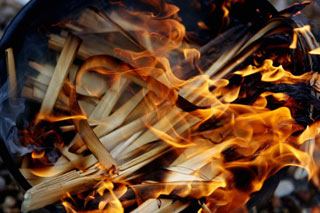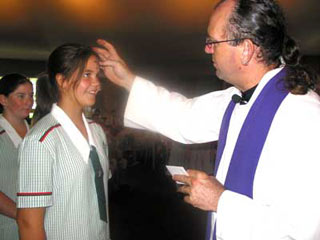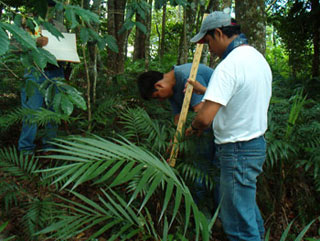Human Flower Project
Tuesday, April 24, 2007
Palm Ash: Sacred Recycling
James Wandersee and Renee Clary follow an Ash Wednesday rite back to its greenery and living root. Here are fascinating details and a strong new pair of concepts for understanding culture: “essence” and “fidelity.”
Wandersee’s and Clary’s decade of work on “plant blindness” was recently featured in the New York Times, though bafflingly they were never mentioned (much like introducing the public to this neat idea called “gravity” without a nod to Isaac Newton). Blindness takes many forms.
As always, thanks for opening our eyes, Jim and Renee.
By James H. Wandersee and Renee M. Clary
EarthScholars™ Research Group
For many Christian denominations, the ashes used in ceremonies on Ash Wednesday (the first day of Lent) are traditionally made by burning the remains of living palm fronds blessed on Palm Sunday of the previous year—a spiritual foreshadowing and ecological recycling that most church members may never have recognized.
 Making palm ashes
Making palm ashes
Saint Luke Catholic Church, Virginia Beach, VA
Photo: Hampton Roads
Palms are one of the best-known and longest-cultivated flowering plant families. Palms’ tiny white flowers, appearing in clusters called inflorescences, often go unnoticed; it is their leaves (a.k.a., fronds) and palm food products (coconut, dates) that attract and fascinate people. The plants in the Bible story are likely date palms. They are associated with Palm Sunday because of the biblical account of Jesus’ triumphant entry into Jerusalem five days before his crucifixion. The living green fronds strewn in Jesus’ path to honor his entrance as the Messiah were also a prelude to his death—hence the later ceremonial use of palm ashes.
The ashes are used to mark a cross on the foreheads of the faithful in Ash Wednesday church services, an outward sign of intended spiritual reflection, mourning, and repentance during the season of Lent. Because palm ash alone does not adhere well to the human forehead, olive oil or anointing oil is often mixed with the ashes to allow the pastor or priest’s thumb to make the mark.
It takes only 4 ounces of palm ash to imprint 1,000 foreheads with the sign of the cross (Commercial ash comes from ovens that incinerate the fronds).
Historically, males had the palm ashes sprinkled on their heads, while women had the mark of the cross drawn with ashes on their foreheads by the thumb of the clergy. Over, time, the ritual first used with women came to be used with men as well.
 Ash Wednesday Service in Queensland, Australia
Ash Wednesday Service in Queensland, Australia
Photo: Seasite
In many churches today, attendance at Ash Wednesday services equals or exceeds that on Christmas and Easter—showing that church-goers value this tradition highly. Since Ash Wednesday falls on a weekday, many people go to work or school that day with ashes on their foreheads. It’s commonplace for those unfamiliar with this plant-based tradition to make the well-intended remark: “Excuse me, but there’s dirt on your face.”
This 12th-century tradition’s cyclic visual metaphor is rich and profound, yet few churches make their own palm ashes anymore. Although some claim this tradition was abandoned due to today’s more stringent fire safety and air quality rules, most church leaders will admit that the convenience of purchasing uniformly fine palm ash is the underlying reason. Many churches buy ashes from church supply houses, which in turn buy from palm ash makers in Texas and Florida. Nearly all the palm ashes used in U.S. churches on Ash Wednesday come from palms other than the biblical date palm.
Approximately 308 million palm fronds are used each year on Palm Sunday in the U.S. For churches that observe this custom, a congregation of 1,500 members will order about 700 fronds for Palm Sunday services. In countries where palm fronds cannot be easily obtained, branches of olive, box elder, spruce and willow trees are used on Palm Sunday in place of palm plants or leaves. In Slovenia, butara (bundles of evergreen sprigs/branches and colorful ribbons are arranged vertically on a central pole or sticks) are used in place of palms. Some churches in the U.S. and abroad use individual, woven crosses of dried palm; others hold that strips of palm, or sprigs and branches of natural woody foliage are equally if not more suitable. Still others are unaware that the palm-like plants they use on Palm Sunday are not true palms at all—such as the Sago Palm, which is not a flowering plant, but a cycad!
 Harvesting Eco-Palms in Mexico
Harvesting Eco-Palms in Mexico
Photo: CEC
Today, an increasing number of U.S. churches celebrate a sustainable Palm Sunday by only using “eco-palms”— fronds that are judiciously harvested by indigenous communities in Mexico and Central America so as to promote palm forest sustainability and maintain critical habitats — rebating 5 cents per palm frond back to the villages for vital social services.
In 2007, churches in every state bought a total of more than 300,000 eco-palm fronds to celebrate Palm Sunday. Although these palms, too, are not the biblical date palms, but native palms, they do meet the criteria of access, convenience, and sustainability. Plant-based traditions DO change. It’s just that, often, we either don’t know the original tradition well enough to notice its changing, or we value essence more than fidelity.




